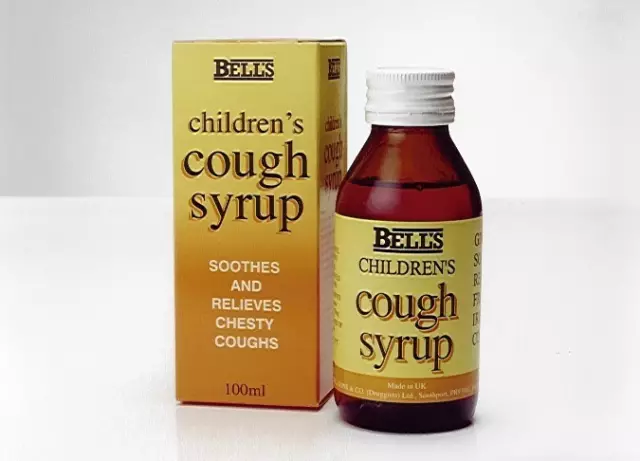- Author Rachel Wainwright [email protected].
- Public 2023-12-15 07:39.
- Last modified 2025-11-02 20:14.
Infectious mononucleosis in children
The content of the article:
- Causes and risk factors
- Symptoms of infectious mononucleosis in children
- Diagnostics
- Treatment of infectious mononucleosis in children
- Possible complications and consequences of infectious mononucleosis in children
- Forecast
- Prevention
Infectious mononucleosis in children is an acute infectious disease that affects the lymphatic and reticuloendothelial systems and manifests itself with fever, polyadenitis, tonsillitis, hepatosplenomegaly, leukocytosis with a predominance of basophilic mononuclear cells.

Source: razvitierebenka.info
The infection is widespread, seasonality has not been identified. Infectious mononucleosis in children of the first two years of life is practically not observed. With age, the incidence rate increases and reaches a maximum in puberty, then gradually decreases again. Boys get sick twice as often as girls.
Synonyms: glandular fever, Filatov's disease, benign lymphoblastosis, “kissing disease”.
Causes and risk factors
The causative agent of infectious mononucleosis is the Epstein-Barr virus (EBV), one of the members of the herpevirus family. Unlike other herpes viruses, it stimulates the growth of host cells (mainly B-lymphocytes), rather than causing them to die. It is this factor that experts explain the carcinogenicity of the Epstein-Barr virus, i.e., its ability to provoke the development of oncological diseases, for example, nasopharyngeal carcinoma or Burkitt's lymphoma.

Source: okeydoc.ru
The only reservoir of infection is the carrier of the infection or the sick person. The virus is shed on a spring Wednesday within 18 months of the initial infection. The main route of transmission is airborne (when coughing, sneezing, kissing), in addition, sexual, intranatal (from mother to child) and transmissible (with blood transfusion) are possible.
Natural susceptibility to infection is high, but infection usually develops an erased or mild form of the disease. The low incidence of infectious mononucleosis in children in the first two years of life is explained by the passive immunity received from the mother during intrauterine development and breastfeeding.
Infectious mononucleosis in children with immunodeficiency conditions can be difficult, with generalization of the infectious process.
Once in the human body, the virus infects the epithelial cells of the upper respiratory tract and oropharynx, contributing to the onset of moderate inflammation. Then, with the flow of lymph, it penetrates into the nearest lymph nodes, leading to the development of lymphadenitis. After that, it enters the bloodstream and is introduced into B-lymphocytes, where it replicates (multiplies), leading to cell deformation. The Epstein-Barr virus persists for a long time in the body, with a decrease in general immunity, its reactivation occurs.
Symptoms of infectious mononucleosis in children
The incubation period can vary widely (from 3 to 45 days), but more often it is 4-15 days.
In most cases, the disease begins acutely, but sometimes a detailed clinical picture may be preceded by a prodromal period, the signs of which are:
- sore throat;
- nasal congestion;
- general malaise, weakness;
- subfebrile temperature;
- headache.
Gradually, the symptoms of intoxication intensify and reach a maximum 2-4 days from the onset of the disease. The temperature can reach 39-40 ° C. The duration of the febrile period is different, from several days (more often) to several months.
One of the main symptoms of infectious mononucleosis in children is tonsillitis, which occurs from the first days of the disease. Inflammation of the tonsils can be catarrhal, lacunar or ulcerative-necrotic, when fibrous films form on their surface.
A characteristic sign of infectious mononucleosis in children is lymphadenopathy. The posterior cervical and jaw lymph nodes are more often affected, less often - cubital, inguinal and axillary. With severe lymphadenopathy, lymph outflow is disturbed, which can lead to a change in the contour of the neck, facial edema, and periorbital edema. With a severe course of infectious mononucleosis in children, bronchial lymph nodes sometimes increase, mesenteric adenitis develops.
In about 25% of children, on the 3-5th day of illness, petichial, roseolous or maculopapular rashes appear on the skin. They are not accompanied by any subjective sensations (burning, itching) and disappear after 1-2 days without leaving any traces.

Hepatosplenomegaly (an increase in the size of the liver and spleen) with infectious mononucleosis in children is quite pronounced and lasts up to 3-4 weeks. In a small part of patients, darkening of urine, icteric staining of the skin, icterus of the sclera, and dyspeptic symptoms are noted.
The peak phase lasts on average 2-3 weeks, after which the body temperature decreases, the size of the liver and spleen return to normal, the symptoms of tonsillitis disappear. Subfebrile condition and adenopathy persist for several weeks.
In some cases, acute infectious mononucleosis in children can become chronic. Most often, the chronic active course of the disease is observed in children with weakened immunity (transplant recipients, HIV-infected patients). The chronic active course of the disease is characterized by a high titer of antibodies to the capsid antigens of the Epstein-Barr virus and histologically confirmed changes in a number of organs (persistent hepatitis, lymphadenopathy, uveitis, hypoplasia of bone marrow elements, interstitial pneumonia).
Symptoms of chronic infectious mononucleosis in children:
- leukopenia;
- exanthema;
- subfebrile temperature;
- signs of damage to the central nervous system.
The congenital form of infectious mononucleosis in children is characterized by multiple developmental defects (cryptorchidism, micrognathia, etc.).
Diagnostics
Laboratory diagnosis of infectious mononucleosis in children includes the following methods:
- general blood test - leukocytosis, lymphocytosis, monocytosis, thrombocytopenia, the appearance of atypical mononuclear cells (lymphoblasts, precursors of cytotoxic T cells, actively participating in the removal of B-lymphocytes affected by the Epstein-Barr virus) are detected;
- biochemical blood test - hypergammaglobulinemia, hyperbilirubinemia, the appearance of cryoglobulins in the serum;
- detection of specific antibodies to viral proteins (reaction of indirect immunofluorescence, drop test);
- virological research - detection of the Epstein-Barr virus in the lavage from the oropharynx. It is used extremely rarely in clinical practice due to the complexity and high cost of this study.
The presence of infectious mononuclear cells in the blood can be detected in children not only with infectious mononucleosis, but also with HIV infection. Therefore, when they are detected, the child must be subjected to an enzyme immunoassay for HIV infection, and then this analysis is repeated twice more with an interval of three months.
Infectious mononucleosis in children requires differential diagnosis with listeriosis, leukemia, lymphoma, toxoplasmosis, viral hepatitis, viral tonsillitis of a different etiology, streptococcal pharyngitis, adenovirus infection, rubella, diphtheria, cytomegalovirus infection, side effects from drugs.
Treatment of infectious mononucleosis in children
In most cases, the disease is treated on an outpatient basis. In the acute phase, bed rest is prescribed, as the condition of the sick child improves and the severity of intoxication decreases, the regime is gradually expanded.
Since the etiotropic treatment of infectious mononucleosis in children has not been developed, symptomatic therapy is performed. For high fever, non-steroidal anti-inflammatory drugs are prescribed. Acetylsalicylic acid should not be prescribed to children in order to lower the temperature, since its intake is accompanied by a high risk of Reye's syndrome.
When a secondary bacterial infection is attached, antibiotics of the penicillin series are prescribed (penicillin, oxamp, ampicillin, oxacillin). Levomycetin and sulfa drugs are not prescribed for children with infectious mononucleosis, since they have a depressing effect on the red bone marrow.
With the development of specific complications of infectious mononucleosis (obstruction of the airways with hyperplastic tonsils), glucocorticosteroids are shown in a short course.
In the event of a ruptured spleen, an emergency surgical intervention is required - splenectomy.
In the complex treatment of infectious mononucleosis in children, diet therapy is of great importance. Since the disease proceeds with impaired liver and spleen functions, the optimal diet is table No. 5 according to Pevzner. The main characteristics of this diet are:
- the content of proteins and carbohydrates meets the needs of the child's body;
- restriction in the diet of fats, especially of animal origin;
- dietary cooking: cooking, baking, stewing;
- exclusion from the diet of foods rich in oxalic acid, purines, extractives, coarse fiber;
- eating 5-6 times a day in small portions at regular intervals.

Sample menu for one day
- first breakfast - oatmeal, cottage cheese pudding, milk tea;
- second breakfast - fruits, grated carrots with an apple, tea with lemon;
- lunch - vegetarian potato soup with a teaspoon of sour cream, baked meat with white sauce, stewed zucchini, rye bread, apple jelly;
- afternoon tea - biscuit biscuits, rosehip broth;
- dinner - mashed potatoes with boiled fish, white bread, tea with lemon.
Possible complications and consequences of infectious mononucleosis in children
The most dangerous complication is rupture of the spleen. It is observed in about 0.5% of cases, is accompanied by massive internal bleeding and requires immediate surgical intervention for health reasons.
Other consequences of infectious mononucleosis in children can be:
- monoarthritis;
- mild hemolytic anemia;
- mumps;
- thrombocytopenic purpura;
- orchitis;
- coagulation disorders;
- meningitis;
- aplastic anemia;
- uveitis;
- hemolytic uremic syndrome;
- episcleritis;
- seizures;
- erythema multiforme;
- cerebellar syndromes;
- hepatitis with liver necrosis;
- meningoencephalitis;
- transverse myelitis.
Forecast
The forecast is favorable. In most cases, the fever disappears within 10-14 days. Splenomegaly and lymphadenopathy persist for up to 4-5 weeks. Death in infectious mononucleosis is extremely rare. It can be caused by rupture of the spleen and obstruction of the airways.
Prevention
Prevention measures aimed at reducing the incidence of infectious mononucleosis in children are similar to those in acute respiratory viral infections. The sick child is isolated in a separate room. Wet cleaning with disinfectants is carried out daily, the room is often ventilated.
A vaccine for specific prevention of Filatov's disease has not been developed. Nonspecific measures for the prevention of infectious mononucleosis in children consist in increasing the general protective forces (prescribing adaptogens, mild immunoregulators, carrying out health measures).
Emergency prophylaxis of infectious mononucleosis in children in contact with patients is rare. Indications for the appointment of a specific immunoglobulin are immunodeficiency states.
YouTube video related to the article:

Elena Minkina Doctor anesthesiologist-resuscitator About the author
Education: graduated from the Tashkent State Medical Institute, specializing in general medicine in 1991. Repeatedly passed refresher courses.
Work experience: anesthesiologist-resuscitator of the city maternity complex, resuscitator of the hemodialysis department.
The information is generalized and provided for informational purposes only. At the first sign of illness, see your doctor. Self-medication is hazardous to health!






